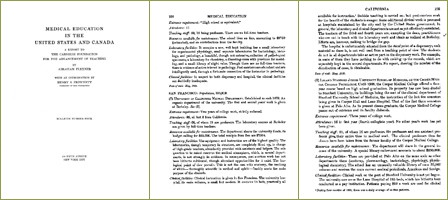Special Topics
THE FLEXNER REPORT IN CONTEXT
by Nancy Rockafellar
Abraham Flexner, 1910
As the example of the University of California School of Medicine reveals, significant reform of the academic curriculum and clinical teaching was well underway by the beginning of the twentieth century in America. Leaders in the medical profession were fully aware of the over-production of physicians in a variety of poorly run proprietary schools, and by 1904 the American Medical Association had created a permanent Council of Medical Education that surveyed and rated the nation's schools. Already by 1910 America's 166 medical schools had been reduced in number to 126.
This atmosphere of national concern for the quality of American medical education prompted the Carnegie Foundation to commission Abraham Flexner to conduct a comprehensive, independent study of the nation's medical schools. His 1910 report, "Medical Education in the United States and Canada," is a classic work typical of the Progressive era. In a muckraking style, Flexner revealed the discrepancies between school catalogue descriptions of courses and clinical opportunities and the realities of medical training in schools throughout the nation. Flexner argued strongly for placement of medical education within the structure of American universities, away from strict control of practitioners, and he emphasized the need to close substandard schools. For Flexner, the desired ideal was truly academic training, with clinical teaching in close geographical association with university science departments.

The arbitrary split between the preclinical sciences at UC Berkeley and clinical instruction based at Parnassus drew the sharpest criticism from Flexner. He worried that "the separation of the clinical branch, with the increasing absorption of the teachers in practice, involves constant danger of fresh alienation....the clinical men at San Francisco simply cannot be at home in the laboratories of Berkeley....laboratories must be duplicated at the clinical site if the clinicians are to be in touch with them." The Regents would consider the issue of consolidation repeatedly over the next four decades, but the basic sciences remained at UC Berkeley until 1958 and the strong vested interests of the San Francisco clinicians kept the Medical Department firmly rooted on Parnassus.
Despite its observed flaws, the UC School of Medicine survived the mass movement to close medical schools in the first decades of the twentieth century. By 1915 the nation's medical schools had been reduced to ninety-six and by 1930 there were only seventy-six schools training the nation's physicians. In 1910 UC was not among the top echelon of schools like Harvard and Johns Hopkins, but of the 148 American schools he surveyed, Flexner rated UC School of Medicine among the top sixteen schools affiliated with state universities that required two years of college instruction for admission. Thus UC was ranked alongside Minnesota, North Dakota, Wisconsin, Michigan, Kansas, Nebraska, and South Dakota.
Flexner's report included maps of existing schools contrasted with "suggested" geographic placement of his ideal number of schools for the future.
References:Flexner, Abraham. Medical Education in the United States and Canada. Boston: Merrymount Press, 1910.
Hudson, Robert P., "Abraham Flexner in Perspective: American Medical Education 1865–1910," Bulletin of the History of Medicine 46 (1972):545-561.
Ludmerer, Kenneth M. Learning to Heal: The Development of American Medical Education. Baltimore: Johns Hopkins University Press, 1985.
